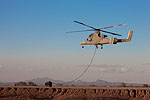K-MAX cargo drone home from Afghanistan, headed to storage
 The Marines’ unmanned cargo chopper is headed for storage now that its time in combat is over.
The Marines’ unmanned cargo chopper is headed for storage now that its time in combat is over.
The K-MAX, a 6,000-pound aircraft built by Lockheed Martin, has returned home, the company announced July 24.
Since 2011, the Marines used two of the drone helicopters to move gear and supplies around the combat zone in Afghanistan, carrying more than 4.5 million pounds of cargo and conducting thousands of delivery missions, according to a Lockheed release.
Most recently, the K-MAX was put to work closing bases in Afghanistan’s Helmand province as the Marine Corps draws down, carrying up to 6,000 pounds of HESCO barriers and infrastructure at a time from smaller outposts back to Camp Leatherneck.
The program has faced setbacks. In June 2013, one of the K-MAX drones in Afghanistan crashed under circumstances that have never been publicly disclosed. A spokeswoman for the Navy’s program executive officer for Unmanned Aviation and Strike Weapons, Emily Burdeshaw, said the investigation into that incident had been completed and submitted to the Naval Safety Center. Officials are assessing the crashed K-MAX, she said, with plans to repair it next year.
For now, the system faces an uncertain future.
Burdeshaw said the the Navy and Marine Corps program officer overseeing the K-MAX is helping Marine Corps headquarters to develop next steps for the system, which may include demonstration flights in 2015 to illustrate the system’s features and uses. In the meantime, the plan is to store the choppers, their ground control stations and additional equipment at the Lockheed Martin Systems Integration Facility in Oswego, North Carolina.
The Marine Corps has yet to initiate the process to make the K-MAX a program of record, she said, and no decision has been made to purchase more of the aircraft.
While much remains unclear, the K-MAX could be well-suited to a future Marine Corps mission focusing on small-unit responses and the Pacific theater.
Lt. Gen. William “Mark” Faulkner, the commanding general of Marine Corps Installations and Logistics, has often spoken of the K-MAX as an example of a developing technology that could sustain future amphibious operations.
“I’m not saying that the current platform in Afghanistan today is necessarily our solution for the future,” Faulkner said in a Marine Corps Times interview last year. “But this kind of capability provides a glimpse into the future — the future of required amphibious sustainment.”